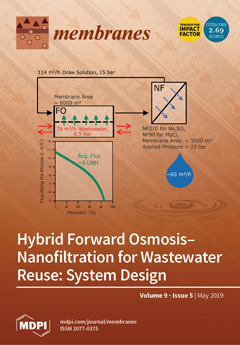Open AccessEditor’s ChoiceReview
Structures, Properties, and Performances—Relationships of Polymeric Membranes for Pervaporative Desalination
by
Nayan Ranjan Singha, Mrinmoy Karmakar, Pijush Kanti Chattopadhyay, Sagar Roy, Mousumi Deb, Himarati Mondal, Manas Mahapatra, Arnab Dutta, Madhushree Mitra and Joy Sankar Deb Roy
Cited by 20 | Viewed by 9601
Abstract
For the fulfilment of increasing global demand and associated challenges related to the supply of clean-and-safe water, PV has been considered as one of the most attractive and promising areas in desalinating salty-water of varied salinities. In pervaporative desalination, the sustainability, endurance, and
[...] Read more.
For the fulfilment of increasing global demand and associated challenges related to the supply of clean-and-safe water, PV has been considered as one of the most attractive and promising areas in desalinating salty-water of varied salinities. In pervaporative desalination, the sustainability, endurance, and structural features of membrane, along with operating parameters, play the dominant roles and impart paramount impact in governing the overall PV efficiency. Indeed, polymeric- and organic-membranes suffer from several drawbacks, including inferior structural stability and durability, whereas the fabrication of purely inorganic membranes is complicated and costly. Therefore, recent development on the high-performance and cost-friendly PV membrane is mostly concentrated on synthesizing composite- and NCP-membranes possessing the advantages of both organic- and inorganic-membranes. This review reflects the insights into the physicochemical properties and fabrication approaches of different classes of PV membranes, especially composite- and NCP-membranes. The mass transport mechanisms interrelated to the specialized structural features have been discussed. Additionally, the performance potential and application prospects of these membranes in a wide spectrum of desalination and wastewater treatment have been elaborated. Finally, the challenges and future perspectives have been identified in developing and scaling up different high-performance membranes suitable for broader commercial applications.
Full article
►▼
Show Figures






